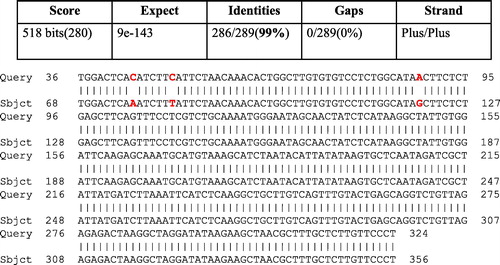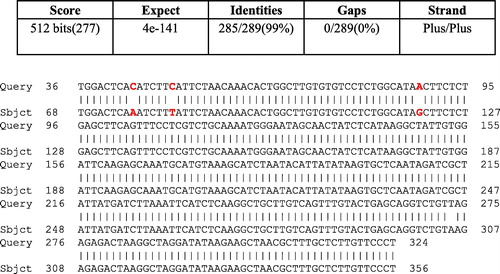Abstract
Bone morphogenetic protein 15 (BMP15/FecX) gene is considered one of the major genes and a candidate marker for the reproduction in farm animals, especially sheep. The present study aimed to detect the genetic polymorphisms of BMP15 gene in sheep using PCR-RFLP technique. In the present study, 115 ewes were assigned into high and low prolificacy categories according to their reproductive history. In high prolific group (n = 20), ewes produced twins more than single births. In the low prolific type (n = 95), the ewes produced single births more than twins. DNA was extracted from blood samples of all ewes, subjected to PCR-RFLP analysis and confirmed by sequence analysis. The PCR products of 356 bp size were cut with HinƒI restriction enzyme. Three digested fragments of 70, 117 and 169 bp were obtained in both types of sheep. All animals were homozygous with CC genotype. In conclusion, the accessible findings did not detect any mutation in FecX gene in sheep, regardless their prolificacy. Therefore, further attempts are necessary to detect other SNP for BMP-15 gene in Egyptian sheep breeds.
1 Introduction
Prolificacy in sheep is determined basically by the ovulation rate i.e. the number of ova released in each estrous cycle. The number of ovulated eggs reflects the number of pre-ovulatory follicles that are produced in each reproductive cycle [Citation1]. Ovulation rate is under the control of single genes that means a single copy of genes increases ovulation rate as Booroola gene [Citation2]. Mutation studies in different prolific sheep breeds showed that the transforming growth factor beta (TGF-β) super family containing the growth differentiation factor 9 (GDF9/FecG), bone morphogenetic protein 15 (BMP15/FecX) and bone morphogenetic protein receptor (BMPR1B/FecB) are the major determinants of the ovulation rate and litter size [Citation3].
Bone morphogenetic protein-15 gene was described firstly in Romney sheep and named the Inverdale gene (FecXI) [Citation4]. BMP-15 locus is X-linked gene and its expression occurs in the oocytes from the primary stage through ovulation [Citation5]. The role of BMP-15 in early follicle development is species-specific and related to the differences between mono- and poly-ovulatory species [Citation6,Citation7]. BMP-15 gene has a crucial role in granulosa cell proliferation and differentiation during ovarian follicular development [Citation8,Citation9]. It stimulates granulosa cell mitosis and suppresses FSH receptor' s expression [Citation7].
The mutation of BMP15/FecX gene includes Lacaune gene (FecXL) identified in the French Lacaune meat sheep with large litters [Citation10]. In the Inverdale ewes, FecXI heterozygotes have more differentiated follicles in the ovary, fewer granulosa cell in these follicles, increased granulosa cells sensitivity to LH in the early stage of the follicle and smaller corpus luteum [Citation11]. FecXH, FecXG and FecX B have similar characteristics to FecXI [Citation12,Citation13].Two novel non-conservative mutations of BMP-15 called FecXGr and FecXO have been identified in French Grivette and Polish Olkuska breeds related to hyper-prolificacy. It is noteworthy that the homozygous ewes of these mutations also had an increased ovulation rate without becoming sterile [Citation14]. BMP15 gene looks to be associated with infertility and super fertility mechanisms in a dosage-sensitive manner [Citation8].
Due to the great effect of BMP-15 gene mutations on ovulation rate, litter size, and prolificacy, this gene is considered one of the major genes and a candidate marker for the reproduction in farm animals, especially sheep. Therefore, the present study aimed to identify the genetic polymorphisms of BMP-15 gene in Egyptian sheep breeds of different prolificacy using PCR-RFLP technique and provide information about desirable genotypes of genes linked with twining.
2 Material and methods
2.1 Animals and blood sampling
A total number of 115 ewes (20 high prolific and 95 low prolific) kept in a private farm at Gamgara village, Benha, Egypt was used in this study (). Blood samples (10 mL) were collected from each animal through the jugular vein into EDTA containing tubes and were stored at −20 °C till DNA extraction. All samples were collected from all animals at the same time regardless their pregnant status (pregnant or not).
Table 1 Numbers of low and high prolific sheep.
Animals were classified according to their reproductive history into two types, high and low of prolificacy. In high prolific type, ewes produced more twin birth than a single birth. While, in the low prolific, ewes produced a single birth more than twin birth. All the animals were kept under the same nutritional condition.
2.2 DNA extraction
DNA was extracted from whole blood using DNA preparation kit (Gena Bio Science, Germany), the concentration and purity of extracted genomic DNA were determined by spectrophotometer. DNA samples were diluted (1:50) with deionized water and the optical density (OD) was measured at wavelength 260 nm against deionized water as a blank. The purity of the isolated DNA was confirmed spectrophotometrically by measuring the OD at 260 and 280 nm, and the ratio of OD at 260/280 was calculated.
2.3 DNA amplification by polymerase chain reaction
The DNA fragment of a 356 bp product of the BMP-15 gene was amplified through polymerase chain reaction technique developed by Mullis et al. [Citation15].The following components: 2.5 µL Buffer 10×, 1.5 µL of 25 mM Mg Cl2, 0.5 µL of 2.5 mM dNTPs mixture, 0.5 µL Primer F,0.5 µL Primer R, 0.3 µL Taq polymerase(5U/µL), 18.2 µL water, and 1 µL DNA were added for each 25 µL reaction mixture.
The primers sequences were F: 5′TTCTCCGTCTAGGGGTATGAG3′ and R: 5′AGGGAACAAGAGCAAAGCGTTAGC3′ according to Shabir and Ganai [Citation16]. The reaction was cycled at 95 °C for 5 min (an initial denaturation), then 35 cycles of denaturation at 95 °C for 1 min, annealing at 58 °C for 1 min, and extension at 72 °C for 1 min, and a final extension at 72 °C for 8 min. PCR products were subjected to electrophoresis in 2.5% agarose gel, 1× TBE buffer with ethidium bromide, at 60 V for 30 min. The bands were visualized under ultraviolet trans-illumination and photographed in Gel-Doc equipment (Bio-Radv, USA).
2.4 Restriction fragment length polymorphism (RFLP)
PCR product for FecX gene was digested with Hinf1 restriction enzyme in a total volume of 30 µL (10 µL PCR product, 2 µL enzyme buffers, 1 µL digestion enzymes and 17 µL water) at 37 °C for 15–20 min. After digestion, the samples’ fragments were visualized by gel electrophoresis at a concentration of 3% agarose.
2.5 Sequencing analysis
The PCR products were analyzed using direct sequencing by Macrogen Incorporation. Sequence analysis and alignment were carried out using NCBI/BLAST/blast suite.
3 Results
A 356 bp product of FecX gene was amplified using PCR-RFLP technique in all sheep under the study (). The PCR products of 356 bp size were cut with HinƒI restriction enzyme into three digested fragments of 70, 117 and 169 bp in all sheep. The fragments were determined and confirmed by sequencing according to the presence of two restriction sites (G/ACTC and G/ATTC). All the animals were homozygous with CC genotype ().
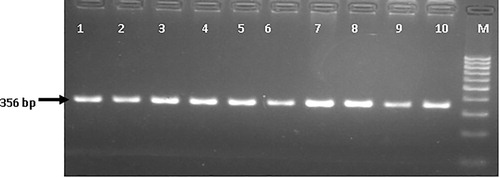
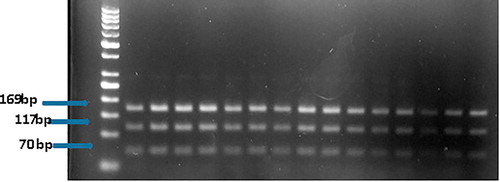
DNA sequence analysis of 356 bp forward (a) and reverse (b) strands of BMP15 gene is presented in and .
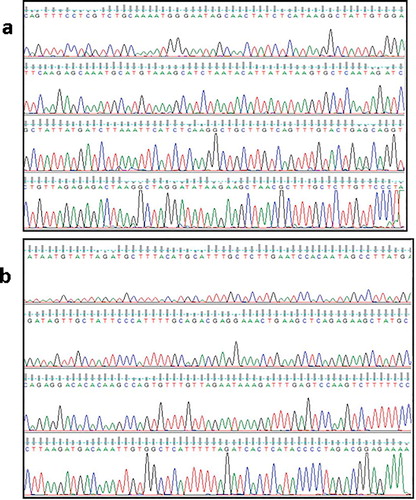
The sequence alignment of 289 bp out of 356 bp of Egyptian sheep BMP15 with published sequence (accession number: FJ600402.1, Ovis aries & FJ600403.1, Ovisaries) was carried out using BLAST and showed 99% identity ( and , respectively).
4 Discussion
Five naturally mutations in exon 2 of the sheep BMP-15 gene have been identified, FecXG (Gallway), FecXB (Belclare), FecXI (Inverdale), FecXH (Hanna), FecXL (Lacaune), and cause infertility in homozygous ewes due to defects in early stages of folliculogenesis [Citation13,Citation17,Citation18].
In the current study, a 356 bp fragment of BMP-15 gene was amplified successfully. The RFLP analysis for Hinf1 demonstrated the existence of one pattern in all sheep at which homozygous CC genotypes showed three digested fragments. DNA sequence analysis of 356 bp forward and reverse strands of BMP-15 gene declared the absence of any polymorphism in the studied sheep breeds and the ovine coding region of BMP-15 showed 99% similarity with other sheep breeds at the nucleotide level. These results indicated that sheep breeds (Barki, Ossimi and Rahmani) either high or low prolific type lack the FecX locus mutation of BMP-15 gene. In this context, none of the Javanese, Thoka, Woodlands, Olkuska, Lacaune, Belclare, and Cambridge sheep had the FecXI mutation despite their high prolificacy [Citation19]. Sequence analysis in former studies revealed that none of the mutations in the BMP-15 were verified in Finn sheep [Citation20], small tailed Han sheep [Citation21], Iranian Baluchi sheep [Citation22] or Sangsari sheep [Citation23].
However, the current results disagree with Elkorshy et al. [Citation24], who identified genetic polymorphism of BMP-15 gene in three native Egyptian breeds (Barki, Rahmani, and Ossimi) as well as two Saudi sheep breeds (Najdi and Harri) using PCR-RFLP with HinfI digestion to identify the genotyping of FecXG loci in exon 2. Also, Hanrahan et al. [Citation13], Davis et al. [Citation25], Guan et al. [Citation26], Chu et al. [Citation27], and Jamshidi et al. [Citation28] documented polymorphism in FecX gene in sheep. Zamani et al. [Citation29] found a new point mutation (G → A) of BMP-15 gene exon 2 in Mehraban and Lori ewes using DNA sequencing methods.
Absence of mutation in our work may be due to the decreased number of ewes and the restriction to one part of the genes. So we need further study with large number of animals and the genetic improvement of ovulation rate through crossbreeding with foreign breed is recommended.
5 Conclusions
The absence of mutation in the FecX locus indicated that it is not the major gene contributes to the large number of lambs per lambing. Further studies using different techniques as genome-wide association are mandatory to delineated the framework governing the twin-lambing performance in Egyptian sheep breeds.
Conflict of interest
The authors declare no conflict of interest.
Acknowledgement
This work was supported by National Research Centre, Egypt (Project No 10060116).
Notes
Peer review under responsibility of Faculty of Veterinary Medicine, Cairo University.
References
- A.GougeonRegulation of ovarian follicular development in primates: facts and hypothesesEndocr Rev171996121155
- LRPiperBMBindonGDDavisThe single gene inheritance of the high litter size of the Booroola MerinoRBLandDWRobinsonGenetics of Reproduction in Sheep1985ButterworthsBoston115125
- S.PolleyS.DeB.BrahmaA.MukherjeeP.V.VineshS.BatabyalPolymorphism of BMPR1B, BMP15 and GDF9 fecundity genes in prolific Garole sheepTrop Anim Health Prod852010122129
- G.H.DavisJ.C.McEwanP.F.FennessyK.G.DoddsK.P.McNattySum O.WaiInfertility due to bilateral ovarian hypoplasia in sheep homozygous (FecXI/ FecXI) for the Inverdale prolificacy gene located on the X chromosomeBiol Reprod461992636640
- F.OtsukaS.YamamotoG.F.EricksonS.ShimasakiBone morphogenetic protein-15 inhibits follicle-stimulating hormone (FSH) action by suppressing FSH receptor expressionJ Biol Chem27620011138711392
- J.R.V.SilvaR.Van Den HurkA.T.H.Van TolJ.A.B.RoelenR.J.FigueiredoExpression of growth differentiation factor 9 (GDF9), bone morphogenetic protein 15 (BMP15), and BMP receptors in the ovaries of goatsMol Reprod Dev7020041119
- R.K.MooreS.ShimasakiMolecular biology and physiological role of the oocyte factor, BMP-15Mol Cell Endocrinol23420056773
- S.M.GallowayK.P.McNattyL.M.CambridgeM.P.E.LaitenenJ.L.JuengelT.S.JokirantaMutations in an oocyte-derived growth factor (BMP15) cause increased ovulation rate and infertility in a dosage-sensitive mannerNat Gen252000279283
- J.L.CrawfordD.A.HeathK.L.ReaderL.D.QuirkeN.L.HudsonJ.L.JuengelOocytes in sheep homozygous for a mutation in bone morphogenetic protein receptor 1B express lower mRNA levels of bone morphogenetic protein 15 but not growth differentiation factor 9Reproduction14220115361
- Bodin L, Elsen JM, Poivey JP, SanCristobal-Gaudy M, Belloc JP, Eychenne F. Hyper-prolificacy in the French Lacaune sheep breed; a possible major gene. In: Proc. 6th World Cong Genet Appl Livest Prod, vol. 27; 1998. p. 11–14.
- G.ShackellN.HudsonD.HeathS.LunL.ShawL.CondellPlasma gonadotropin concentrations and ovarian characteristics in Inverdale ewes that are heterozygous for a major gene (FecXI) on the X chromosome that influences ovulation rateBiol Reprod48199311501156
- G.H.DavisK.G.DoddsR.WheelerN.P.JayEvidence that an imprinted gene on the X chromosome increases ovulation rate in sheepBiol Reprod642001216221
- J.P.HanrahanS.M.GreganP.MulsantM.MullenG.H.DavisR.PowellMutations in the genes for oocyte-derived growth factors GDF9 and BMP15 are associated with both increased ovulation rate and sterility in Cambridge and Belclare sheep (Ovis aries)Biol Reprod702004900909
- J.DemarsS.FabreJ.SarryR.RossettiH.GilbertL.PersaniGenome-wide association studies identify two novel BMP15 mutations responsible for an atypical hyper prolificacy phenotype in sheepPLoS Genet942013e1003482 10.1371/journal.pgen.1003482
- K.MullisF.FaloonaS.ScharfR.SaikiG.HornH.ErlichSpecific enzymatic amplification of DNA in vitro: the polymerase chain reactionCold Spring Harb Symp Quant Biol51Pt 11986263273
- M.ShabirT.GanaiNucleotide sequencing and DNA polymorphism studies of BMP 15 gene in Corriedale and local Kashmir valley sheep (Ovis aries)Gene4992012231235
- K.P.McNattyS.M.GallowayT.WilsonP.SmithN.L.HudsonA.O'ConnellPhysiological effects of major genes affecting ovulation rate in sheepGenet Sel Evol3720052538
- L.BodinE.Di PasqualeS.FabreM.BontouxP.MongetL.PersaniA novel mutation in the bone morphogenetic protein 15 gene causing defective protein secretion is associated with both increased ovulation rate and sterility in Lacaune sheepEndocrinol1482007393400
- G.H.DavisS.M.GallowayI.K.RossS.M.GreganJ.WardB.V.imbkarDNA tests in prolific sheep from eight countries provide new evidence on origin of the Booroola (FecB) mutationBiol Reprod66200218691874
- M.P.MullenJ.P.HanrahanDirect evidence on the contribution of a missense mutation in GDF9 to variation in ovulation rate of Finn sheepPLoS One942014e95251 10.1371/journal.pone.0095251
- I.SithimarjithaPolymorphism of bone morphogenetic protein 15 (BMP15) gene and its potential as a candidate gene for the prolificacy of Nilagiri sheep [M.V.Sc. Thesis]2009Tamil Nadu Veterinary and Animal Sciences UniversityChennai, India
- F.MoradbandG.RahimiM.GholizadehAssociation of polymorphisms in fecundity genes of GDF9, BMP15 and BMP15-1B with litter size in Iranian Baluchi sheepAsian-Aust J Anim Sci24201111791183
- M.M.KasiriyanS.H.HafezianN.HassaniGenetic polymorphism BMP15 and GDF9 genes in Sangsari sheep of IranInt J Genet Mol3120113134
- N.ElkorshyK.F.MahrousL.M.SalemGenetic polymorphism detection in four genes in Egyptian and Saudi Sheep breedsWorld Appl Sci J2720133343
- G.H.DavisL.BalakrishnanI.K.RossT.WilsonS.M.GallowayB.M.LumsdenInvestigation of the Booroola (FecB) and Inverdale (FecXI) mutations in 21 prolific breeds and strains of sheep sampled in 13 countriesAnim Reprod Sci9220068796
- F.GuanR.LiuG.Q.ShiJ.T.AiD.G.MaoL.G.YangPolymorphism of FecB gene in nine sheep breeds or strains and its effects on litter size, lamb growth and developmentActa Genet Sin332006117124
- M.X.ChuZ.H.LiuC.L.JiaoY.Q.HeL.FangS.C.YeMutations in BMPR-IB and BMP-15 genes are associated with litter size in small tailed Han sheep (Ovisaries)J Anim Sci852007598603
- R.JamshidiM.MehdiH.HafezeyaApplication of PCR-RFLP technique to determine BMP-15 gene polymorphism in Sangsari sheep breed of IranJ Anim Vet Adv8200919061910
- P.ZamaniS.NadriR.SaffaripourA.AhmadiF.DashtiR.AbdoliA new mutation in exon 2 of the bone morphogenetic protein 15 gene is associated with increase in prolificacy of Mehrabanand Lori sheepTrop Anim Health Prod472015855860

